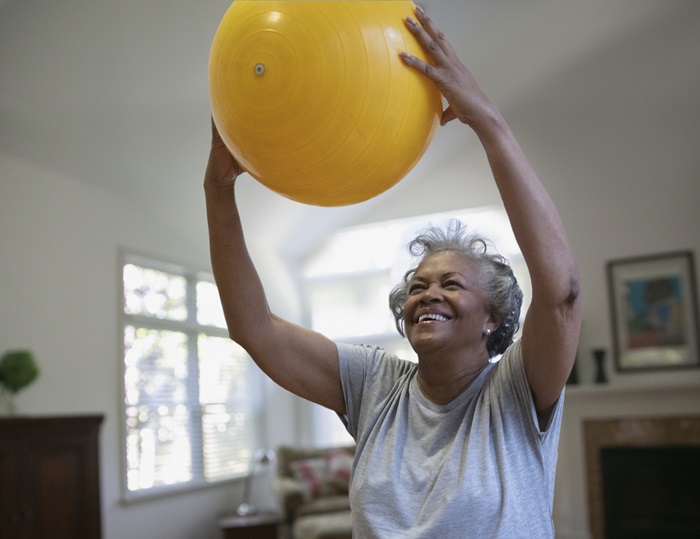How Exercise Impacts Parkinson’s Disease

August 30, 2021
Parkinson’s disease is a progressive neurodegenerative disease of the brain that affects about 1.2 million people in the United States, with about 60,000 new patients diagnosed every year.
The rate of progression of the disease in each individual is variable in intensity and severity. Parkinson’s disease generally is described as progressing through five stages that consider posture and functional ability. But over the years, Parkinson’s disease can lead to various motor and non-motor symptoms that may include:
- Impairment in walking and balance
- Postural instability
- Freezing of gait (FOG)
- Diminished vocal quality
- Trouble swallowing
- Difficulties with activities of daily living
- Sudden blood pressure changes when standing up
- Constipation
- Depression or anxiety
- Psychosis
- Difficulties maintaining sleep
- Cognitive or intellectual decline
Medications are effective at managing some of the symptoms, but there is no cure for Parkinson’s disease. One of the most widely studied and effective treatments is a regimen of vigorous exercise, says Roger Rossi, D.O., the director of the Parkinson’s Disease and Movement Disorders Program at JFK Johnson Rehabilitation Institute.
How Exercise Helps Parkinson’s Patients
A regimen of intense exercise has been shown to be very beneficial, positively influencing many aspects of the disease. Studies have shown that various forms of exercise may reduce falls and associated injuries/fractures, slow the progression of the disease and even delay the onset of symptoms. Exercise may also positively affect various non-motor aspects of the disease including depression, anxiety and sleep. “Exercise has been shown to affect the brain,” Dr. Rossi says. “You’re exercising the brain in addition to the muscular and skeletal systems.”
He adds, “In the brain, exercise causes the release of various neurotrophic factors—basically, these are molecules that support the growth, survival and differentiation of both developing and mature neurons, so they enhance the brain’s development and functioning potential.” This allows the brain to protect and nurture neurons that counter or slow the decline of motor and cognitive function.
Intense exercise is defined as elevating the heart rate, commonly between 60 percent and 80 percent of an individual’s maximum heart rate. So doing intense exercise doesn’t necessarily suggest excessive endeavors and can be achievable for all, he says.
Which Exercises Help?
The first evidence-based exercise research and commonly referred to study that showed benefits for Parkinson’s patients was Argentinian tango and dance.
More commonly understood exercises for individuals with Parkinson’s disease include those that strengthen bones and muscles, Dr. Rossi says. These types of exercises can correct some of the physical impacts of the disease, such as overall weakness, fatigue, balance, dexterity and posture. In addition to skilled therapies, community-based activities such as Pilates and yoga, as well as structural integration techniques are good for overall strength, balance and core stability. Often these activities are done in a social setting, so in addition to physical benefits, they offer psychosocial and cognitive well-being that can diminish depression and anxiety.
“There are many types of exercise, and the challenge remains identifying the specific exercise type best suited for each individual as well as duration and intensity.” Dr. Rossi says. “You have to identify what each individual patient needs based on their symptoms, physical exam and importantly their individual goals. We want them to be able to enjoy these activities so it is sustainable and most effective.”
The material provided through HealthU is intended to be used as general information only and should not replace the advice of your physician. Always consult your physician for individual care.
Find a doctor near me
8 Possible Causes (and Treatments) for Your Dizziness

Research shows that dizziness, vertigo and balance problems affect about 15 percent of U.S. adults each year.
Find a doctor near me

The Numbers Behind Parkinson's Disease
Understand Parkinson's disease statistics. Learn key facts and figures. Access reliable information now.

How to Identify Early Signs of Stroke
Recognize stroke symptoms? Learn early stroke signs from Dr. Pavuluri. Get timely medical attention to reduce disability risk.

4 Common Injuries from Combat Sports
Craig Van Dien, M.D., says that he frequently sees hand and wrist injuries related to combat sports.

Can COVID-19 Cause a Stroke?
COVID-19 and Stroke: Learn how COVID-19 may impact your brain health from leading neurologists Drs. Thomas & Steineke. Call 800-822-8905.
